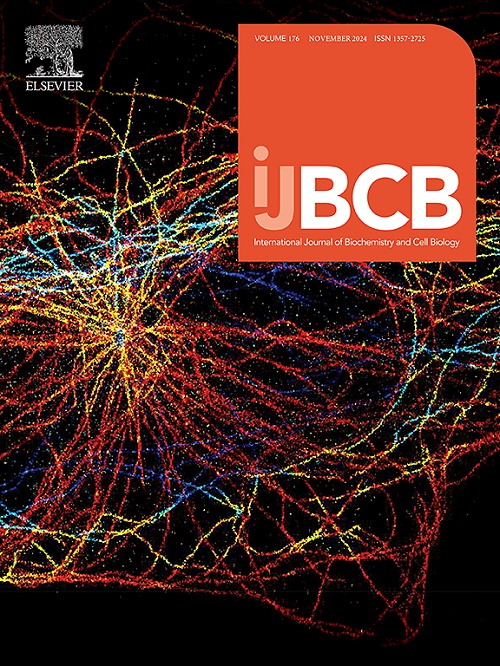Mitochondrial and peroxisomal fission in cortical neurogenesis
IF 2.8
3区 生物学
Q2 BIOCHEMISTRY & MOLECULAR BIOLOGY
International Journal of Biochemistry & Cell Biology
Pub Date : 2025-03-28
DOI:10.1016/j.biocel.2025.106774
引用次数: 0
Abstract
The human brain is unique in its cellular diversity, intricate cytoarchitecture, function, and complex metabolic and bioenergetic demands, for which mitochondria and peroxisomes are essential. Mitochondria are multifunctional organelles that coordinate various signaling pathways central to neurogenesis. The dynamic morphological changes of the mitochondrial network have been linked to the regulation of bioenergetic and metabolic states. Specific protein machinery is dedicated to mitochondrial fission and fusion, allowing organelle distribution during cell division, organelle repair, and adaptation to environmental stimuli (excellent reviews have been published on these topics [Kondadi and Reichert, 2024; Giacomello et al., 2020; Tilokani et al., 2018; Kraus et al., 2021; Navaratnarajah et al., 2021]). In parallel, peroxisomes contain over 50 different enzymes which regulate metabolic functions that are critical for neurogenesis (Berger et al., 2016, Hulshagen et al., 2008). Peroxisomes share many of the components of their fission machinery with the mitochondria and undergo fission to help meet metabolic demands in response to environmental stimuli (Schrader et al., 2016). This review focuses primarily on the machinery involved in mitochondrial and peroxisomal fission. Mitochondrial fission has been identified as a critical determinant of cell fate decisions (Iwata et al., 2023, Iwata et al., 2020, Khacho et al., 2016, King et al., 2021, Prigione and Adjaye, 2010, Vantaggiato et al., 2019, Kraus et al., 2021). The connection between alterations in peroxisomal fission and metabolic changes associated with cellular differentiation remains less clear. Here, we provide an overview of the functional and regulatory aspects of the mitochondrial and peroxisomal fission machinery and provide insight into the current mechanistic understanding by which mitochondrial and peroxisomal fission influence neurogenesis.
皮层神经发生中的线粒体和过氧化物酶体裂变。
人类大脑在细胞多样性、复杂的细胞结构、功能和复杂的代谢和生物能量需求方面是独一无二的,线粒体和线粒体在其中发挥着重要作用。过氧化物酶体是必不可少的。除了以ATP的形式提供能量,线粒体。过氧化物酶体是协调各种信号的多功能细胞器。神经发生的中枢通路。的动态形态变化。线粒体网络与生物能量和代谢状态的调节有关。特定的蛋白质机制专门用于线粒体的裂变和融合,这允许细胞器分布在细胞分裂,细胞器修复和。对环境刺激的适应(在这些方面已经发表了很好的评论。主题[Kondadi & Reichert 2024;Giacomello et al. 2020;Tilokani et al. 2018;克劳斯出版社。2021年;Navaratnarajah et al. 2021])。这篇综述主要集中在机器上。参与线粒体和过氧化物酶体裂变。线粒体分裂使细胞能够检测和响应外部信号,使其成为细胞命运决定的关键决定因素(Iwata等,2023;Iwata et al. 2020;Khacho et al. 2016;King et al. 2021;Prigione & Adjaye 2010;Vantaggiato et al. 2019;Rosenberg et al. 2023, Kleele et al.2021, Kraus et al.2021)。过氧化物酶体裂变变化之间的联系。与细胞分化相关的代谢变化仍然不太清楚。在这里,我们提供线粒体的功能和调控方面的概述。以及过氧化物酶体的裂变机制并提供对当前机制的洞察。了解线粒体和过氧化物酶体裂变对神经发生的影响。
本文章由计算机程序翻译,如有差异,请以英文原文为准。
求助全文
约1分钟内获得全文
求助全文
来源期刊
CiteScore
8.10
自引率
0.00%
发文量
124
审稿时长
19 days
期刊介绍:
IJBCB publishes original research articles, invited reviews and in-focus articles in all areas of cell and molecular biology and biomedical research.
Topics of interest include, but are not limited to:
-Mechanistic studies of cells, cell organelles, sub-cellular molecular pathways and metabolism
-Novel insights into disease pathogenesis
-Nanotechnology with implication to biological and medical processes
-Genomics and bioinformatics

 求助内容:
求助内容: 应助结果提醒方式:
应助结果提醒方式:


